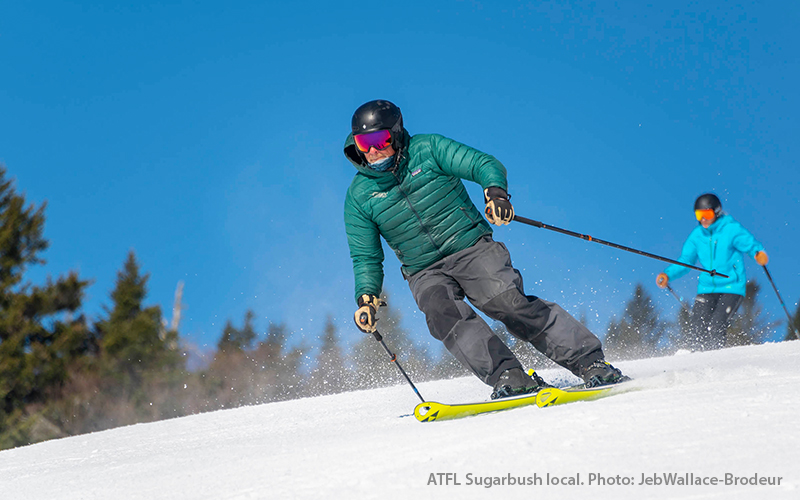Riding the singles line on a powder day recently, I rode a chair with two middle-aged men who, judging by their rental equipment and street-level clothing, were not experienced skiers. The instructor in me ventured a chairlift conversation. They had little idea of what made up the skier mindset. During this proffering of free advice, one of the men heard something that was familiar to him. I was discussing the energy from the terrain that is available for turning the skis. He was a professional stage actor and an acting coach. “Energy” he said, he understood. He gains energy from the stage. Finding a commonality of experience, he enthused and asked questions. Very soon we were trading analogies and found that we were speaking the same language.
Sourcing energy for each turn is a mindset that propels and directs your skiing. If you are fall line hunting and you are always looking for places to fire the ski downhill and across the fall line, that searching will make you aware of those terrain variations. You could be aiming for flat snow to make a clean arc, or a small depression in the snow that allows the ski to bend easily at the center.
No matter the situation, there is energy available to the skier. A great deal of skiing relies on the proper management of energy. These are the key forces at play while descending a ski slope.
As example we return to our friend the equation: F=MA, or Force equals Mass times Acceleration. A skier weighing 165 pounds (74.84Kg) that descends the 1445-foot vertical drop of the Heaven’s Gate chair, (assuming a 20-degree pitch), generates 255 Newtons of force. With GS skiing on Ripcord, we could assume that a skier would make approximately 25 turns. If you divide 255 Newtons by 25, there are 10.2 Newtons of available force, per turn, that require no muscle or ski energy, just the effect of the body falling through space.
So, there is energy that is either available for flow or resistance. It all depends on how you use those forces whether you will ski efficiently or inefficiently. Obviously, resisting the tremendous force of gravity at 9.8 meters per second squared would seem an inefficient use of that energy. All this math is just to prove the existence of available energy. As an instructor, any argument that serves to convince skiers to use the available forces rather than fight them is worthy of pursuit.
As local skiers, we have an obligation to de-mystify skiing for visitors. I always encourage skiers to go to the top of the mountain. Why would you miss that? As well, they should try new equipment. “Demos” are available, and, at very least, take those old skis in for a tune, right after skiing! Every skier has gone through it and every skier can remember someone who helped them on their way up. I have skied with locals all over the world, and most of them have pulled out all the stops to show off their home mountain. Whistler/Blackcomb locals showed me Powder Magazine quality chutes and off-piste terrain. A Chilean ski patroller ventured into unavailable terrain with me. The van driver in Chamonix led us on an all-day tour of the Argentiere Glacier!
A sweet pair of goggles with mirror- finished lenses on a sunny day . . . but not if they are scratched or clouded. After some rock skiing, the edges are ignored and dulled, worsening the skiing, and causing additional mistakes and damage. You don’t have what you once had because you didn’t take care of it, in the moment, when it mattered. The same causation could easily be applied to your health or relationships.
Skiing is a sport that pulls you in and asks, “How deep can you, or will you go?” Can you carve with the efficiency of available energy or are you going to keep your old, tired habits of resisting the hill? Is this the day, is this the run, is this the turn when you finally decide to get “on” the hill and not behind it?
Swoosh . . . flying downhill. That is the sport; it is flying downhill. And each turn, the backside of each spring bump, is an opportunity to create that experience.
We craft these days. We are the crafters of these stories. What if this is Paradise? How could it not be? Blue skies, snow, sunshine . . . cold, crafted, and hazy IPA’s? What could be better? How could a heaven be any different? There is even a sign, a Black Diamond sign at the top of both Lincoln Peak and General Stark Mountain indicating the way to Paradise. Will it be what you expect? It depends on what you bring if you give it all due respect.
Mad River Valley Notes
If you want to hear some great interviews with World Cup ski racers, tune in to the podcast: Arc City by GMVS graduate Jimmy Krupka. Jimmy’s podcast is genuine and insightful, ski racing fans will appreciate the quality of his interviews.













